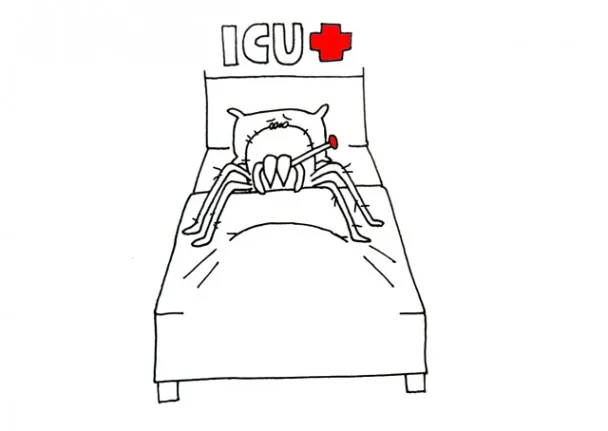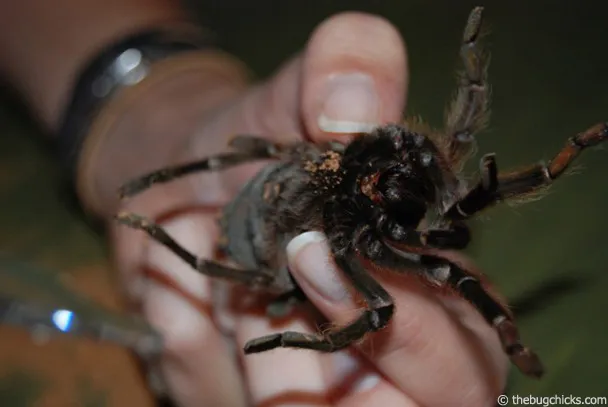What is Tarantula ICU?
Tarantula ICU (Intensive Care Unit) is a controlled environment designed to provide specialized care for sick or injured tarantulas. It mimics optimal conditions for recovery, focusing on providing a stable and stress-free environment. This is crucial because tarantulas are sensitive to environmental changes, and a compromised immune system can make them vulnerable to various health issues. The primary goal of a tarantula ICU is to stabilize the spider, address the underlying cause of its illness, and facilitate a return to good health. This setup goes beyond the standard terrarium, offering precise control over temperature, humidity, and other critical factors.
When to Consider Tarantula ICU
Knowing when to move your tarantula to an ICU is critical for its survival. Several signs indicate the need for this level of care. If your tarantula exhibits lethargy, loss of appetite, or unusual behaviors, it is time to take action. Difficulty molting, including incomplete molts or prolonged molting periods, can be a significant cause for concern. Physical injuries, such as those caused by falls or attacks from prey, also necessitate immediate care. Additionally, if you observe any symptoms of illness, such as respiratory problems or parasitic infections, an ICU setup can provide the best chance for recovery. Timely intervention can drastically improve the prognosis for your tarantula.
Signs Your Tarantula Needs ICU

Several key indicators suggest your tarantula requires ICU care. Watch for changes in activity levels, such as a sudden decrease in movement or a refusal to eat. A swollen abdomen can signal a serious problem, and any visible injuries need immediate attention. Observe its molting process carefully; difficulties here often point to underlying issues. Look out for labored breathing, as this is a critical symptom of respiratory distress. Parasites like mites can also indicate the need for ICU treatment. If you detect any of these issues, consider moving your tarantula into an ICU setup as soon as possible to increase its chances of survival. Early detection and action can save the life of your pet.
Preparing the Tarantula ICU Setup
Preparing a suitable ICU environment is crucial. Start by selecting a clean, appropriately sized enclosure. A clear plastic container with a secure lid works well. The size should be proportional to your tarantula; it should be large enough for movement but small enough to maintain stable conditions. Ensure it is easy to clean and disinfect. The setup should include a substrate that retains moisture but does not promote mold growth. Sphagnum moss or paper towels are good options. Essential equipment also includes a reliable thermometer and hygrometer to monitor temperature and humidity. A small water dish and, if necessary, a heating source like a heat mat controlled by a thermostat are also important for maintaining the correct environmental conditions. Preparing the ICU carefully increases the chances of a successful recovery.
Choosing the Right Enclosure
Selecting the appropriate enclosure is a fundamental step. The enclosure should provide a safe and controlled environment for the spider to recover. The enclosure size must consider the tarantula’s size and species. A clear plastic container offers excellent visibility for monitoring the tarantula’s condition. Ensure the container is easy to disinfect and has a secure lid to prevent escape and maintain humidity. Modify the container by adding ventilation holes, strategically placed to allow airflow without causing drafts. Consider the type of tarantula you are caring for; some species need more space, while others prefer a more confined environment. Careful consideration here helps minimize stress and encourages recovery.
Maintaining Temperature and Humidity

Maintaining precise temperature and humidity levels within the ICU is vital. Tarantulas thrive within specific environmental ranges, and deviations can hinder recovery. Use a thermometer to constantly monitor the temperature. For most species, a temperature between 75-85°F (24-29°C) is ideal. Humidity can be monitored using a hygrometer. Achieving the right humidity levels may require misting the enclosure, adjusting the substrate, or using a humidifier. Use a heat mat controlled by a thermostat to provide gentle, consistent warmth if necessary. Always provide fresh water in a shallow dish to ensure hydration. Regular monitoring and adjustments are critical to ensure the environmental conditions are optimal for the tarantula’s health.
Providing Proper Ventilation
Adequate ventilation is essential to prevent the buildup of harmful gases and maintain air quality within the ICU setup. Proper ventilation helps to control humidity levels and reduces the risk of mold and bacterial growth. Ensure the enclosure has ventilation holes, properly sized and spaced, to allow for airflow without creating drafts. The placement of these holes is important; they should be positioned to encourage cross-ventilation. Inspect the ventilation openings regularly to ensure they are not blocked by substrate or other materials. The appropriate balance of air exchange and humidity retention is vital for promoting the tarantula’s health and facilitating its recovery. Careful attention here can prevent respiratory problems.
Monitoring Your Tarantula
Close observation of your tarantula is critical throughout its stay in the ICU. Monitor its behavior, appetite, and overall appearance daily. Note any changes in activity levels, such as increased or decreased movement. Examine the spider for any signs of injury, illness, or parasites. Check the tarantula’s abdomen for swelling or discoloration. Observe its molting process closely, as difficulties here often indicate underlying problems. Keep a log of your observations to track progress and detect any worsening conditions. Regular observation helps you to quickly identify and respond to any changes in your tarantula’s health, facilitating timely interventions that can improve its outcome.
Feeding and Hydration in ICU

Providing proper nutrition and hydration is essential for recovery. Offer appropriately sized prey items, such as crickets or mealworms, based on your tarantula’s size. If your tarantula is not eating, you might need to assist with feeding. You can try offering pre-killed prey or gently placing food near the tarantula. Always have a shallow water dish available with fresh, clean water. Hydration is essential, and a consistently available water source is vital for survival. Consider misting the enclosure to help maintain humidity, which also encourages hydration. Adjust feeding and hydration based on your tarantula’s specific needs and its ability to eat. A tailored approach to feeding will improve the chances of recovery.
Administering Medication if Necessary
Administering medication to a tarantula can be a complex task. Never attempt to medicate your tarantula without consulting a veterinarian experienced with exotic animals. The vet can diagnose the condition and prescribe the appropriate medication and dosage. Medications may be administered through various methods, including topical application or, in some cases, injection. Follow the veterinarian’s instructions precisely to ensure the correct dosage and method of administration. Observe your tarantula closely after administering medication to watch for any adverse reactions. Prompt and accurate administration of medication significantly improves the chances of recovery from illnesses and infections.
Common Tarantula Illnesses Requiring ICU
Several health problems may require ICU treatment. These issues range from relatively mild to life-threatening, and all require focused care. Recognizing the signs of these common ailments is crucial for providing the appropriate care and increasing the odds of a positive outcome. Many of these issues are manageable with the right care and early intervention. Monitoring your tarantula for symptoms is critical. If you detect any of these problems, providing ICU care could improve the chances of a full recovery for your tarantula. The main focus is on respiratory problems, parasitic infections, and molting issues.
Respiratory Problems

Respiratory problems can be severe in tarantulas. These issues often manifest as labored breathing, lethargy, and a lack of appetite. Infections, environmental irritants, and poor enclosure conditions can lead to respiratory distress. If you observe these symptoms, it is time to take action. The ICU environment offers controlled conditions to aid in recovery. Maintaining ideal temperature and humidity levels and ensuring proper ventilation can help ease respiratory distress. A veterinarian can prescribe medications, if necessary, such as antibiotics or antifungals. Regular monitoring and prompt treatment are crucial to prevent respiratory complications.
Parasitic Infections
Parasitic infestations can severely affect tarantula health. Mites are a common parasite, often found on the tarantula’s abdomen and around its mouth. These parasites feed on the spider’s hemolymph, causing stress and potential health complications. Symptoms of parasitic infections include lethargy, irritation, and changes in the tarantula’s appearance. Removal of the mites is vital. You can use various methods, including gently cleaning the tarantula, changing the substrate, and sometimes using appropriate medications. The ICU setup helps to provide a clean and controlled environment that aids in parasite removal. Regular cleaning of the enclosure and the use of preventive measures, such as quarantine, are key to preventing future infestations.
Molting Issues
Molting is a natural process in tarantulas, but problems during molting can be life-threatening. Incomplete molts, where the spider fails to shed its exoskeleton completely, are a major concern. Prolonged molting periods, lethargy, and difficulty moving can indicate issues. Providing an ICU environment can help by maintaining optimal temperature and humidity, which supports a successful molt. Increased humidity can help to soften the old exoskeleton. If the molt is unsuccessful, gently assist the spider. It is important to act quickly to prevent injury. Monitor the spider closely throughout the molting process and provide a supportive environment. Providing the right environment can help the tarantula molt successfully.
Post-ICU Care and Recovery

Once your tarantula begins to recover, you can gradually transition it back to its original habitat. This process requires careful observation and planning. Monitor the tarantula’s behavior and appetite as you slowly reduce the ICU intervention. Gradually decrease the temperature and humidity levels in the ICU to match those in the original enclosure. Gradually reintroduce the tarantula to its habitat over several days. During this period, continue to monitor the tarantula for any signs of stress or illness. Make sure that it starts eating again and behaves normally. Continue to observe it closely for a few weeks to ensure a full recovery. Patience and careful monitoring are key to the post-ICU recovery phase. Consider a slightly changed environment in the original enclosure, if the cause of the illness was found.
Reintroducing Your Tarantula to its Habitat
Reintroducing your tarantula to its habitat is a gradual process that demands patience. First, prepare the habitat for the return. Clean and disinfect the enclosure thoroughly, and ensure that it has appropriate substrate, temperature, and humidity levels. Then, consider the gradual reintroduction. Place the tarantula in a separate, temporary enclosure near its original habitat for a few days, to allow it to adjust. Slowly increase the time it spends in its original habitat. The transition period should be slow. Keep monitoring the tarantula’s behavior, appetite, and activity levels during the transition. Be ready to return it to the ICU if any signs of illness reappear. Providing a calm and safe transition helps your tarantula to thrive.
